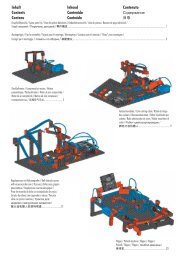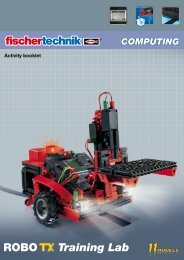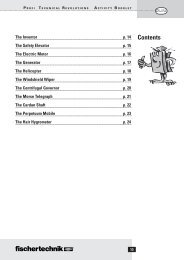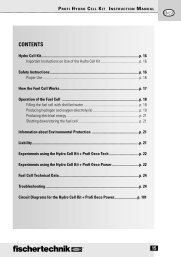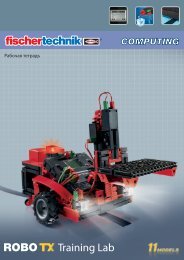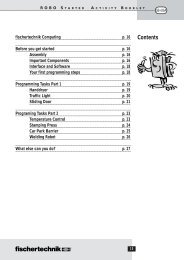computing - Fischertechnik
computing - Fischertechnik
computing - Fischertechnik
Create successful ePaper yourself
Turn your PDF publications into a flip-book with our unique Google optimized e-Paper software.
COMPUTING<br />
Color Value<br />
White<br />
Red<br />
Blue<br />
Phototransistor<br />
(sensor)<br />
Light barrier<br />
+<br />
Bellows suction cup<br />
fischertechnik suction cup<br />
Suction cup circuit diagram<br />
Sensors and actuators<br />
Lamp<br />
(actuator)<br />
11<br />
ROBO TX ElectroPneumatic<br />
Connect the color sensor to I3 using with the black and green cable and to + with the<br />
red cable (see circuit diagram in assembly instructions).<br />
Task 1 - Defining color values:<br />
First check the values output by the ROBO TX Controller for the parts in the interface<br />
test (white, red, blue). Use the interface test in ROBO Pro for this purpose.<br />
Set input I3, connected to the color sensor, to analog 10V (color sensor).<br />
Make a small table and enter the values you have measured. Also observe the changes<br />
when the distance to the colored surface or the ambient light changes.<br />
In addition a light barrier is used for the next task. This consists of a light-sensitive sensor<br />
(phototransistor) and a lens tip lamp (actuator) as light source.<br />
Phototransistor<br />
You can also call the phototransistor a "brightness sensor." This is a "sensor" that reacts<br />
to brightness. In a light barrier it is the counter-part of the lens tip lamp. When there<br />
is a high degree of brightness, that is when the transistor receives light from the lens<br />
tip lamp, it conducts electricity. If the light beam is interrupted, the transistor does not<br />
conduct any electricity. Caution! Pay attention to the polarity when connecting the<br />
phototransistor to the power supply. Red = positive.<br />
Lens tip lamp<br />
This is an incandescent bulb with built-in lens to focus the light. It is required to build a<br />
light barrier. The lens tip lamp can be recognized by its gray base.<br />
Electric motor<br />
The direct current motor converts electrical energy into mechanical energy. This results<br />
in the rotational movement of the motor. A motor also has a gearbox. With this gearbox<br />
you can reduce the speed of the motor and simultaneously increase the torque (motor<br />
pulling force).<br />
Vacuum pump<br />
You need a vacuum pump for the model to produce<br />
the vacuum to pick up the parts. Since the<br />
vacuum pumps used for industrial applications are<br />
very expensive, you can use a simpler solution for<br />
producing a vacuum. You need two cylinders with<br />
connected piston rods. Connect connection A to<br />
the compressor over the solenoid valve. Connection<br />
B leads to the suction cup. When the valve<br />
is actuated, both pistons are pushed forward. If<br />
the suction cup is positioned on a part, the air is<br />
sucked in by the two pistons producing a vacuum.<br />
The bellows type suction cup has a lifting function and can be used on flat as well as<br />
slightly arched surfaces.<br />
B<br />
A




